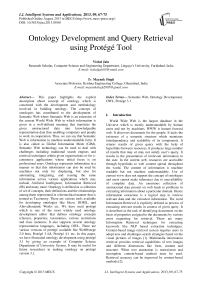Ontology Development and Query Retrieval using Protégé Tool
Автор: Vishal Jain, Mayank Singh
Журнал: International Journal of Intelligent Systems and Applications(IJISA) @ijisa
Статья в выпуске: 9 vol.5, 2013 года.
Бесплатный доступ
This paper highlights the explicit description about concept of ontology which is concerned with the development and methodology involved in building ontology. The concept of ontologies has contributed to the development of Semantic Web where Semantic Web is an extension of the current World Wide Web in which information is given in a well-defined meaning that translates the given unstructured data into knowledgeable representation data thus enabling computers and people to work in cooperation. Thus, we can say that Semantic Web is information in machine understandable form. It is also called as Global Information Mesh (GIM). Semantic Web technology can be used to deal with challenges including traditional search engines and retrieval techniques within given organizations or for e-commerce applications whose initial focus is on professional users. Ontology represents information in a manner so that this information can also be used by machines not only for displaying, but also for automating, integrating, and reusing the same information across various applications which may include Artificial Intelligence, Information Retrieval (IR) and many more. Ontology is defined as a collection of set of concepts, their definitions and the relationships among them represented in a hierarchical manner that is termed as Taxonomy. There are various tools available for developing ontologies like Hozo, DOML, and AltovaSemantic Works etc. We have used protégé which is one of the most widely used ontology development editor that defines ontology concepts (classes), properties, taxonomies, various restrictions and class instances. It also supports several ontology representation languages, including OWL. There are various versions of protégé available like WebProtege 2.0 beta, Protégé 3.4.8, Protégé 4.1 etc. In this paper, we have illustrated ontology development using protégé 3.1 by giving an example of Computer Science Department of University System. It may be useful for future researchers in making ontology on protégé version 3.1.
Semantic Web, Ontology Development, OWL, Protégé 3.1
Короткий адрес: https://sciup.org/15010466
IDR: 15010466
Список литературы Ontology Development and Query Retrieval using Protégé Tool
- Carlo Meghini_ Fabrizio Sebastiani and Umberto Straccia, “A Model of Multimedia Information Retrieval”.
- Henning Muller, Nicolas Michoux, David Bandon and Antoine Geissbuhler, “A Review of Content Based Image Retrieval Systems in Medical Applications - Clinical Benefits and Future Directions”.
- http://lpt.fri.uni-lj.si/research/15-semantic-web-and-ontologies/6-semantic-web-and-ontologies.
- Harold Boley, Said Tabet and Gerd Wagner, “Design Rationale of RuleML: A Markup Language for Semantic Web Rules, http://ruleml.org/papers/DesignRationaleRuleML-SWWS01paper20.pdf.
- Gagandeep Singh, Vishal Jain, “Information Retrieval (IR) through Semantic Web (SW): An Overview”, In Proceedings of CONFLUENCE 2012- The Next Generation Information Technology Summit, September 2012, 23-27.
- Christoph Bussler, Dieter Fensel, Alexander Maedche, “A Conceptual Architecture for Semantic Web Enabled Web Services”, NSF-EU Workshop on Database and Information Systems Research for Semantic Web and Enterprises, April 3 - 5, 2002 Amicalola Falls and State Park, Georgia.
- P. Lambrix, “Towards a Semantic Web for Bioinformatics using Ontology-based Annotation”, in: proceedings of the 14th IEEE international workshops on Enabling Technologies: Infrastructures for Collaborative Enterprises, 2005, pp.3-7.
- Semantic Web Education by Vladan Devedzic, Springer, springer.com ,2006, Pages 33-50.
- http://www.comp.rgu.ac.uk/staff/fh/CM3028/index.php
- Dario Bonino, “Architectures and Algorithms for Intelligent Web Applications”, December 2005.
- Zhaohui Wu, Huajun Chen, “Semantic Grid – Model, Methodology and Applications”, Springer, 2008, Page 26-32.
- Junhua Qu, Chao Wei, Wenjuan Wang, Fei Liu, “Research on a Retrieval System Based on Semantic Web”, 2011 IEEE International Conference on Internet Computing and Information Services. http://doi.ieeecomputersociety.org/10.1109/ICICIS.2011.142.
- Grigoris Antoniou and Frank van Harmelen, “Web Ontology Language: OWL”.
- Thomas B. Passin, “Explorer's Guide to the Semantic Web”, Manning Publications Co., 2004.
- Grigoris Antoniou and Frank Von Hormelen, “A Semantic Web primer”, The MIT Press Cambridge, Massachusetts London, England.
- www.dime-co.com/column/uploads/1/article_4.txt.
- Ee-Peng Lim and Aixin Sun, “Web Mining- The Ontology Approach”.
- http://www.sciam.com/article.cfm?id=the-semantic-web.
- Sergey Sosnovsky, Darina Dicheva, “Ontological technologies for user modeling”, Int. J. Metadata, Semantics and Ontologies, Vol. 5, No. 1, 2010.
- http://semanticweb.org/wiki/Semantic_Web.
- Noy and McGuinness ,“Ontology Development 101: A Guide to Creating Your First Ontology”, Stanford University.
- Sugumaran and Storey, “The Role of Domain Ontologies in Database Design : An Ontology Management and Conceptual Modeling Environment”, ACM Transactions on Database Systems, Vol. 31, No. 3, September 2006, Pages 1064–1094.
- Chandrasekaran, Josephson, Benjamins. "What are Ontologies and why do we need them". IEEE Intelligent Systems, Jan/Feb 1999.
- Time Berners-Lee, The Semantic Web Revisited, IEEE Intelligent Systems, 2006.
- Lina Tankelevičienė, Ontology and Ontology Engineering: Analysis of Concepts, Classifications and Potential Use in E-Learning Context, Technical Report MII-SED-08-01, February 2008.
- Daniel L. Rubin, Natalya F. Noy and Mark A. Musen, “Protégé: A Tool for Managing and Using Terminology in Radiology Applications”, Journal of Digital Imaging. 2007 Nov; 20(Suppl 1)34-46.


